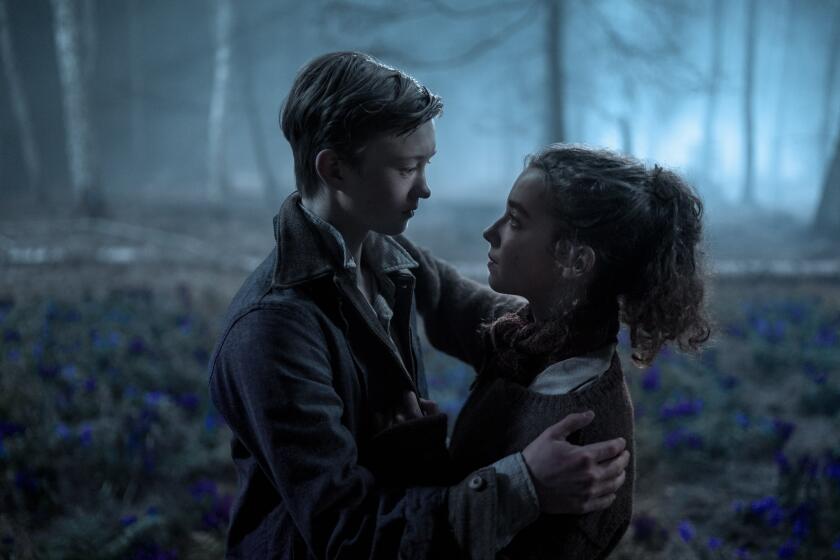Recovering Teenagers See Themselves in Realistic Drug Movie
The pact Crystal made with her young drug partners in case of an overdose seems almost unreal: “We had an agreement my friends and myself. It was like, just in case I OD, drop me off at the hospital door.”
Crystal, 17, tells of becoming addicted to heroin when she was 13, of ditching classes and shooting up in the bathroom, of being busted for purchasing heroin from an undercover cop. And a plan in case of OD similar to one played out in the drug movie “Traffic.”
Articulate, with a tawny complexion and long hair, Crystal could be any young girl, going to any high school in any city. But maybe that’s the point.
She is sitting now in a darkened Beverly Hills screening room watching not her own story but one that she says accurately traces the pleasure and desperation of getting high as well as the emotional and physical wreckage of drug use.
Occupying the plush seats next to her are four other teenagers, all receiving drug rehabilitation at a Santa Ana branch of Phoenix House, who have come to view the movie “Traffic.”
It is a sleek, contemporary take on drug trafficking starring Michael Douglas and Catherine Zeta-Jones that has become a critical and popular hit. From Washington think tanks to Southern California living rooms and rehab centers like the nonprofit Phoenix House, the movie is helping to bring home the discussion of drug policies and usage.
The five residents of the Orange County center watched the film at the offices of the distributor, USA Films, and talked about it afterward with a Times reporter.
“A lot of times they try to sugarcoat things, but if I had seen this movie maybe things would have been different for me,” said Annie, a 17-year-old from Fullerton with a history of alcohol and marijuana use, of running away, petty theft, failing grades and truancy.
The movie story weaves three interrelated tales, one concerning the nation’s newly appointed drug czar who discovers that his teenage daughter, a bright, high-achieving student, is using drugs.
About the only scenes that did not resonate with Annie and the others were those in which the daughter and her boyfriend venture into Cincinnati’s inner city to score drugs. In real life, they say, drugs are available at suburban schools, at the mall, at the house down the street even in the best neighborhoods.
“My mom was a speed freak, and she would take me on missions to get drugs. We never went downtown but always drove to a rich area, some big mansion,” said Annie, whose fair features and blond hair are remarkably similar to those of 18-year-old actress Erika Christensen, who brings youthful authenticity to the movie daughter’s harrowing descent.
“It could be your next-door neighbor,” added Mitchell, 17, a slight boy with dark hair.
Mitchell ran away from home at the age of 12 and started using alcohol, amphetamines, cocaine, LSD and heroin. Arrested for violating his probation, he spent three months in Orange County Juvenile Hall before joining Phoenix House.
Jaime, 16, started smoking marijuana at 13. At 14 he joined a street gang and began compiling a juvenile record that includes arrests for possession of crystal meth, burglary and probation violations. A judge gave him the option of doing time or receiving treatment.
Jennifer, 17, said she began using drugs out of boredom. She was arrested and placed on probation for possession of methamphetamines and ordered into a six-week treatment program. As is often the case, she suffered a relapse, much like the movie daughter.
The Phoenix House teens were surprised that the movie accurately captured many of the small details of drug life.
Like the agreement between Crystal and her friends to ditch each other at a hospital so that their drug use would not be unmasked. In the movie, the daughter and her friends panic when one of the boys overdoses. They decide to drop him at the entrance of a hospital but are spotted by police and arrested before they can get away.
Said Crystal: “I had two friends overdose on me, but we never went to the hospital. I was able to revive them. Yes, it was scary. It hurt for a while, but after that it didn’t make any difference. I still needed to get that fix.”
“You get so far into your addiction that you’re willing to do anything,” said Annie. “I’d steal from the Stater Bros. store. I’d pawn anything my mom and dad gave me, CDs, radios, anything that was worth at least $10.”
“In the movie, the daughter steals from her mom and dad for drug money,” said Jaime. “As bad as I was into drugs I still had respect for my parents. But I’d jack cars and steal stereos. I started breaking into houses; once I was walking down the street with six VCRs under my arms. The next morning I would wake up and wouldn’t believe what I had done. What if I’d run into a cop?”
Knowing your very life is on the brink also means little.
“I had gotten to the point that I think the next time I would’ve stuck a needle in my arm I would have been dead,” said Mitchell. “I could feel my heart beating wrong. I would white out. You get to the point where you don’t care whether you die or not.”
*
In the movie, the drug czar asks his wife how long she’s known about the daughter’s drug use, and she says six months. Inaction by parents in the face of a hard reality is very common, said Howard Friend, director of adult services in California for Phoenix House and a former drug user who spent three years in prison in New York.
It should not surprise anyone that parental denial can last so long, he said. “I run a parent group, and they are in such denial. A Beverly Hills mother came in after her daughter had overdosed on heroin, and the doctor had told her she might die. She pulled through, but the reality for the mother is she hopes it doesn’t happen again. In fact, it is likely to happen again.”
“I think my grandparents knew I was using, but they didn’t want to say anything,” Mitchell said. “My teachers at school knew. During first period class I would come in on speed all fast and hyper or come in smoking pot all slow and tired, and they noticed the changes. One teacher pulled me aside and said she knew and that she cared too much about me to let it continue. But I didn’t listen. It went in one ear and out the other.”
*
The teens are by no means fully recovered, but they all have plans: Crystal wants to become a cosmetologist; Jaime sees himself as a computer graphics animator for Disney one day; Mitchell wants to integrate his love of guitar playing with his talents as a comic book artist; Annie intends to become a lawyer; and Jennifer, who has experience training seeing-eye dogs, wants to continue working with animals.
If the Phoenix House teens bear witness to the unaccountable resiliency of young people, they also speak of the importance of communication between parents and their children.
“My dad has always been supportive, but when I came to Phoenix House,” said Jennifer, “he told me this was my last chance. It was a reality check for me. I didn’t want him out of my life.”
Friend said the movie sends a powerful reminder that if parents “see a change in attitude, that the child is ditching classes, dressing differently or hanging out with a whole new set of friends, there must be something going on.”
“The message for parents is don’t ever turn your back on them, always be there and support them,” said Crystal.
More to Read
Only good movies
Get the Indie Focus newsletter, Mark Olsen's weekly guide to the world of cinema.
You may occasionally receive promotional content from the Los Angeles Times.











